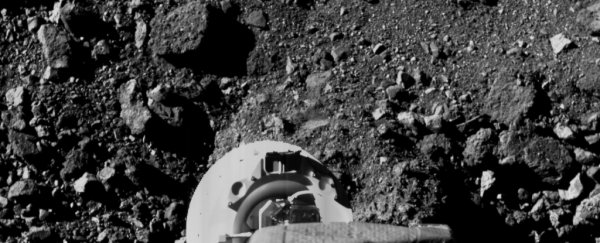NASA's OSIRIS-REx spacecraft is getting ready for its big moment. OSIRIS-REx (Origins, Spectral Interpretation, Resource Identification, Security, Regolith Explorer) is at asteroid Bennu, preparing to collect a sample of ancient rock. And collecting that sample means taking step after meticulous step.
OSIRIS-REx performed a series of rehearsal maneuvers in recent weeks. Each of these maneuvers brought it closer to Bennu's surface, before the spacecraft retreated into orbit again. Eventually, it will perform its risky touch-and-go sampling procedure.
The most recent maneuver was the "Checkpoint" maneuver. Checkpoint brought the spacecraft to within 75 meters (246 ft) of Bennu's surface. Previous maneuvers saw it approach within 620 meters (2,034 ft), then 250 meters (820 ft).
OSIRIS-REx is a long way away from Earth, and its sampling operation will all be done autonomously. The latest maneuver is called Checkpoint because at 75 meters away from the surface, the spacecraft's autonomous system will check its position and velocity and adjust its trajectory before continuing to the surface.
 The Checkpoint Rehearsal was the most recent rehearsal maneuver. (NASA/Goddard/University of Arizona)
The Checkpoint Rehearsal was the most recent rehearsal maneuver. (NASA/Goddard/University of Arizona)
In this maneuver, it reached its Checkpoint for the first time. Since this is only a rehearsal, OSIRIS-REx then performed its checkpoint burn and backed away from the asteroid, to orbit at a safe distance.
During these increasingly close approaches, NASA's spacecraft is capturing a wealth of images of its sampling site. These images are stored onboard as part of the spacecraft's Natural Feature Tracking ( NFT) system.
When the time for the sampling maneuver comes, OSIRIS-REx will compare its real-time images from its cameras to its onboard images, and will use those comparisons to guide itself down to the sampling site on Bennu's boulder-strewn surface.
During the Checkpoint maneuver OSIRIS-REx also deployed its sampling mechanism, the Touch-And-Go Sample Acquisition Mechanism, or TAGSAM.
Normally TAGSAM is folded onto the spacecraft, and this test of its deployment was successful. Numerous instruments on OSIRIS-REx also gathered data during this closest-yet approach.
When it is time to collect the sample, OSIRIS-REx will descend to the surface, but the spacecraft itself won't land. Instead, TAGSAM will be deployed to the surface. TAGSAM will emit a puff of nitrogen to kick up dust from the asteroid.
The nitrogen will propel small pieces of the regolith into TAGSAM's sampling head. There are also passive contact pads on the end of the instrument that will collect samples.
The goal is to collect 60 grams (2.1 oz) of material in particles smaller than 2 cm (0.8 in).
 The April 2020 sample collection rehearsal . (NASA/Goddard/University of Arizona.)The Natural Feature Tracking system will guide OSIRIS-REx down to the surface, and there's enough fuel for multiple attempts. TAGSAM also has enough nitrogen for three sample-collection attempts, should there be problems.
The April 2020 sample collection rehearsal . (NASA/Goddard/University of Arizona.)The Natural Feature Tracking system will guide OSIRIS-REx down to the surface, and there's enough fuel for multiple attempts. TAGSAM also has enough nitrogen for three sample-collection attempts, should there be problems.
The latest maneuver was also a successful test for the NFT. NASA confirmed that NFT performed well, saying in a press release "Checkpoint rehearsal also gave the team confirmation that OSIRIS-REx's Natural Feature Tracking (NFT) guidance system accurately estimated the spacecraft's position and speed relative to Bennu as it descended toward the surface."
"This rehearsal let us verify flight system performance during the descent, particularly the autonomous update and execution of the Checkpoint burn," said Rich Burns, OSIRIS-REx project manager at NASA's Goddard Space Flight Center in Greenbelt, Maryland.
"Executing this monumental milestone during this time of national crisis is a testament to the professionalism and focus of our team. It speaks volumes about their 'can-do' attitude and hopefully will serve as a bit of good news in these challenging times."
OSIRIS-REx's first sampling attempt is scheduled for August 25th. TAGSAM will contact the surface for about five seconds, and collect its sample. If all goes well, that sample should be returned to Earth on 24 September, 2023.
This article was originally published by Universe Today. Read the original article.
